ABS Lancia Thesis 2006 Owner handbook (in English)
[x] Cancel search | Manufacturer: LANCIA, Model Year: 2006, Model line: Thesis, Model: Lancia Thesis 2006Pages: 386, PDF Size: 8.69 MB
Page 25 of 386
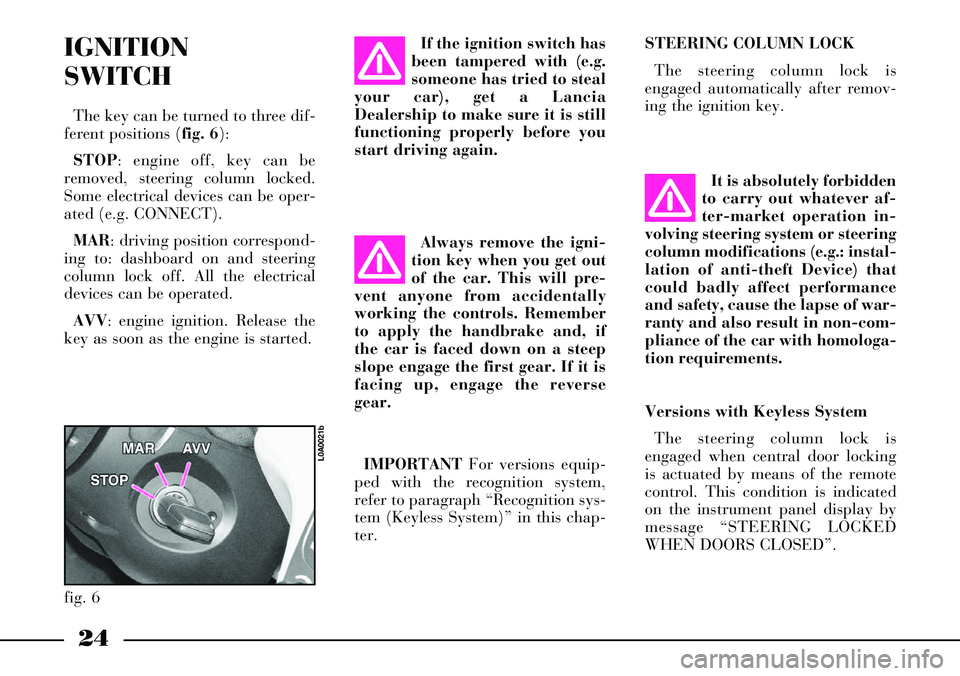
It is absolutely forbidden
to carry out whatever af-
ter-market operation in-
volving steering system or steering
column modifications (e.g.: instal-
lation of anti-theft Device) that
could badly affect performance
and safety, cause the lapse of war-
ranty and also result in non-com-
pliance of the car with homologa-
tion requirements.
24
STEERING COLUMN LOCK
The steering column lock is
engaged automatically after remov-
ing the ignition key.IGNITION
SWITCH
The key can be turned to three dif-
ferent positions (fig. 6):
STOP: engine off, key can be
removed, steering column locked.
Some electrical devices can be oper-
ated (e.g. CONNECT).
MAR: driving position correspond-
ing to: dashboard on and steering
column lock off. All the electrical
devices can be operated.
AVV: engine ignition. Release the
key as soon as the engine is started.If the ignition switch has
been tampered with (e.g.
someone has tried to steal
your car), get a Lancia
Dealership to make sure it is still
functioning properly before you
start driving again.
Always remove the igni-
tion key when you get out
of the car. This will pre-
vent anyone from accidentally
working the controls. Remember
to apply the handbrake and, if
the car is faced down on a steep
slope engage the first gear. If it is
facing up, engage the reverse
gear.
IMPORTANTFor versions equip-
ped with the recognition system,
refer to paragraph “Recognition sys-
tem (Keyless System)” in this chap-
ter.
fig. 6
L0A0021b
Versions with Keyless System
The steering column lock is
engaged when central door locking
is actuated by means of the remote
control. This condition is indicated
on the instrument panel display by
message “STEERING LOCKED
WHEN DOORS CLOSED”.
Page 71 of 386
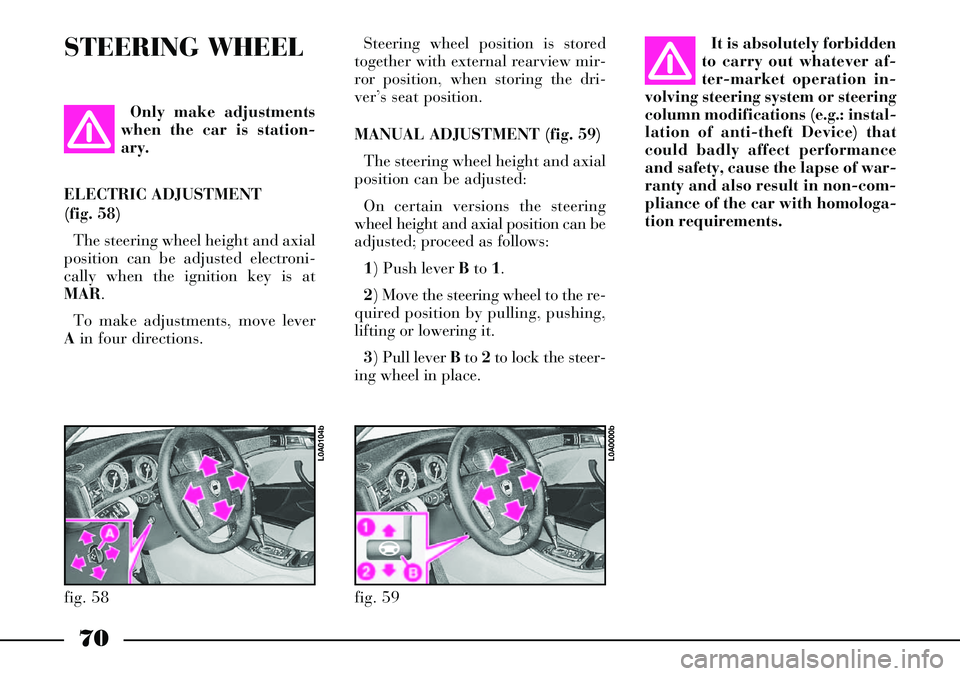
It is absolutely forbidden
to carry out whatever af-
ter-market operation in-
volving steering system or steering
column modifications (e.g.: instal-
lation of anti-theft Device) that
could badly affect performance
and safety, cause the lapse of war-
ranty and also result in non-com-
pliance of the car with homologa-
tion requirements.
70
STEERING WHEELSteering wheel position is stored
together with external rearview mir-
ror position, when storing the dri-
ver’s seat position.
MANUAL ADJUSTMENT (fig. 59)
The steering wheel height and axial
position can be adjusted:
On certain versions the steering
wheel height and axial position can be
adjusted; proceed as follows:
1) Push lever Bto 1.
2) Move the steering wheel to the re-
quired position by pulling, pushing,
lifting or lowering it.
3) Pull leverBto 2to lock the steer-
ing wheel in place. Only make adjustments
when the car is station-
ary.
ELECTRIC ADJUSTMENT
(fig. 58)
The steering wheel height and axial
position can be adjusted electroni-
cally when the ignition key is at
MAR.
To make adjustments, move lever
Ain four directions.
fig. 58
L0A0104b
fig. 59
L0A0000b
Page 91 of 386
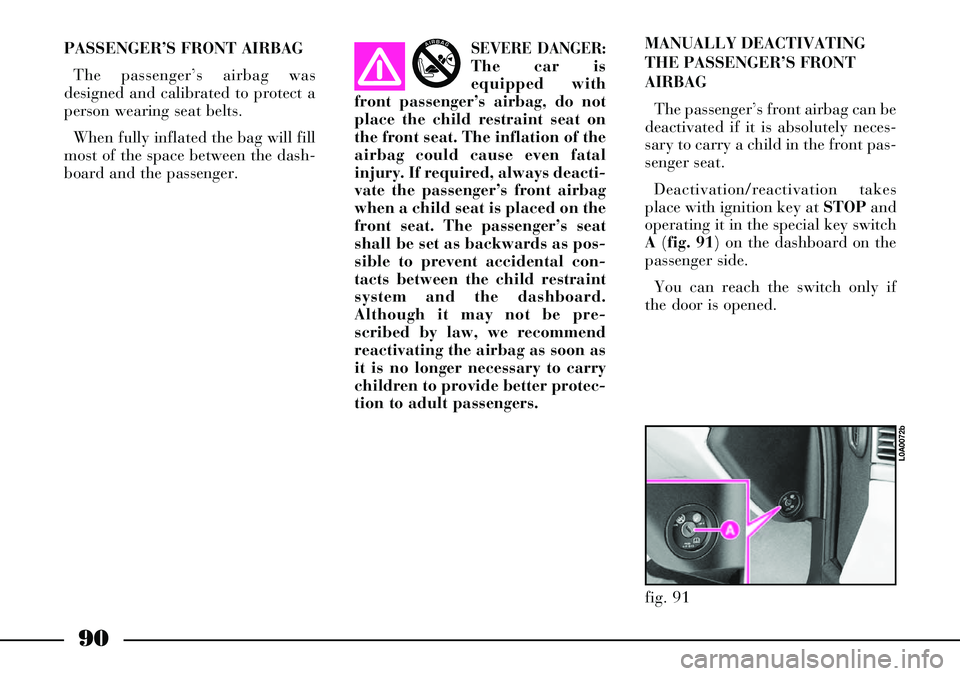
90
SEVERE DANGER:
The car is
equipped with
front passenger’s airbag, do not
place the child restraint seat on
the front seat. The inflation of the
airbag could cause even fatal
injury. If required, always deacti-
vate the passenger’s front airbag
when a child seat is placed on the
front seat. The passenger’s seat
shall be set as backwards as pos-
sible to prevent accidental con-
tacts between the child restraint
system and the dashboard.
Although it may not be pre-
scribed by law, we recommend
reactivating the airbag as soon as
it is no longer necessary to carry
children to provide better protec-
tion to adult passengers.
AIRBAGPASSENGER’S FRONT AIRBAG
The passenger’s airbag was
designed and calibrated to protect a
person wearing seat belts.
When fully inflated the bag will fill
most of the space between the dash-
board and the passenger.MANUALLY DEACTIVATING
THE PASSENGER’S FRONT
AIRBAG
The passenger’s front airbag can be
deactivated if it is absolutely neces-
sary to carry a child in the front pas-
senger seat.
Deactivation/reactivation takes
place with ignition key at STOPand
operating it in the special key switch
A(fig. 91) on the dashboard on the
passenger side.
You can reach the switch only if
the door is opened.
fig. 91
L0A0072b
Page 120 of 386
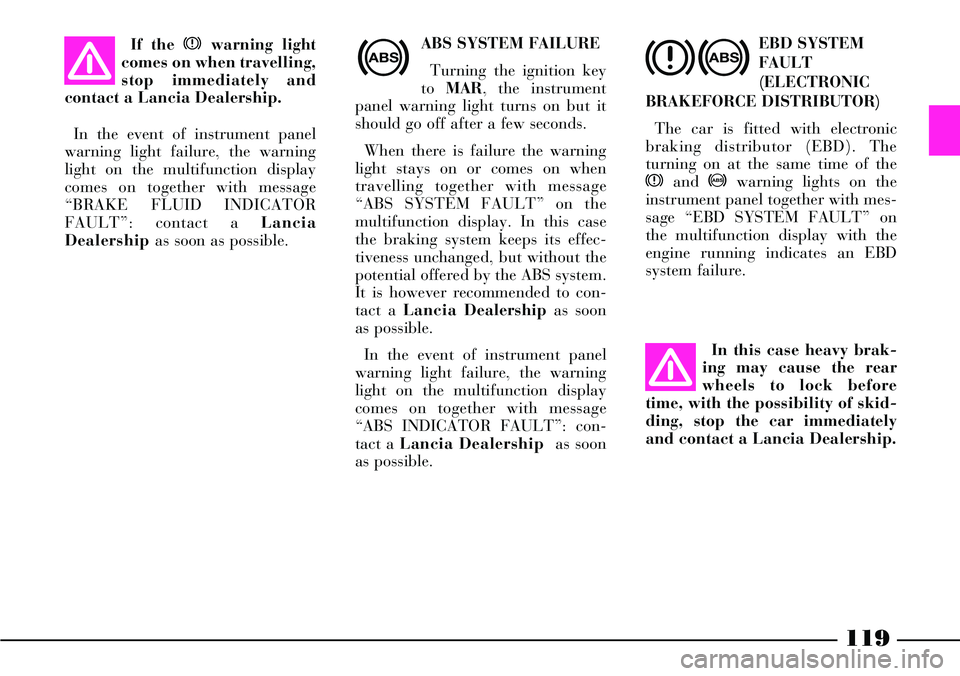
119
ABS SYSTEM FAILURE
Turning the ignition key
to MAR, the instrument
panel warning light turns on but it
should go off after a few seconds.
When there is failure the warning
light stays on or comes on when
travelling together with message
“ABS SYSTEM FAULT” on the
multifunction display. In this case
the braking system keeps its effec-
tiveness unchanged, but without the
potential offered by the ABS system.
It is however recommended to con-
tact a Lancia Dealershipas soon
as possible.
In the event of instrument panel
warning light failure, the warning
light on the multifunction display
comes on together with message
“ABS INDICATOR FAULT”: con-
tact a Lancia Dealership as soon
as possible.In this case heavy brak-
ing may cause the rear
wheels to lock before
time, with the possibility of skid-
ding, stop the car immediately
and contact a Lancia Dealership.
>
EBD SYSTEM
FAULT
(ELECTRONIC
BRAKEFORCE DISTRIBUTOR)
The car is fitted with electronic
braking distributor (EBD). The
turning on at the same time of the
xand >warning lights on the
instrument panel together with mes-
sage “EBD SYSTEM FAULT” on
the multifunction display with the
engine running indicates an EBD
system failure.
x>
If the xwarning light
comes on when travelling,
stop immediately and
contact a Lancia Dealership.
In the event of instrument panel
warning light failure, the warning
light on the multifunction display
comes on together with message
“BRAKE FLUID INDICATOR
FAULT”: contact a Lancia
Dealership as soon as possible.
Page 129 of 386

128
ABS SYSTEM
Warning light/symbol
>
Message
SYSTEM
UNAVAILABLE
ABS SYSTEM FAULT
GO TO DEALER
ABS INDICATOR FAULT
GO TO DEALERMeaning of the message
System setting in progress
ABS system failure:
in this case the braking system
keeps its effectiveness,
but without the potential offered
by the ABS system. Drive with the
utmost care specially
in all cases of less than
perfect grip.
System is ok but the
warning light is failing and
cannot indicate the presence of
future failures of the ABS systemAction
–
Contact a Lancia Dealership
Contact a Lancia Dealership
ESP (ELECTRONIC STABILITY PROGRAM)
Warning light/symbol
á
Message
SYSTEM
UNAVAILABLE
ESP SYSTEM FAULT
GO TO DEALER
ESP INDICATOR FAULT
GO TO DEALERMeaning of the message
System setting in progress
ESP system failure
System is ok but the warning
light is failing and cannot indicate
the presence of future
failures/interventions of the ESP
systemAction
-
Contact a Lancia Dealership
Contact a Lancia Dealership
Page 175 of 386

174
Lift cover Aset at the driver's left
and press button Bto reset the fuel
cut-off switch.
Resetting the circuit breaker
Before resetting the cir-
cuit breaker, carefully
check for any fuel leaks or
damages to the car electric devices
(e.g.: headlights).Circuit breaker is located on the left
side of the boot, inside a box directly
set and connected to the battery pos-
itive terminal.
To reach the circuit breaker:
1) Open the tailgate.
2) Loosen knob A(fig. 130) and re-
move the battery cover B.
3) Press tabs A(fig. 131) and re-
move cover B.
4) Press button A(fig. 132) to reset
the circuit breaker.Initialising the control units of
the door locks, air conditioner
and ESP system
After resetting the circuit breaker, to
restore correct door locking, air con-
ditioning and ESP system, perform
the following operations:
1) Close the doors and the tailgate,
fit the key into the lock of one of the
front doors and perform a door cen-
tralised opening/closing cycle.
2) Start the engine and turn on the
compressor of the conditioner, setting
a lower temperature value than that
of the environment and check
whether the led on the disconnection
push button of the conditioner com-
pressor òis lit.
3) Turn the steering wheel one
fourth turn at least (the car can be at
standstill but the engine shall be run-
ning) and start running the car for a
few metres in a straight line until the
ESP warning light
áis off.
fig. 131
L0A0031b
fig. 132
L0A0347b
Page 176 of 386

ELECTRIC PARKING BRAKE
(EPB) (fig. 133)
The car is fitted with the EPB
(Electric Parking Brake) that cuts in
when switching the engine off and
will cut out when starting the engine
and pressing the accelerator pedal
(for manual gearbox versions when
releasing the clutch pedal at the
same time). The EPB can also be
disengaged manually by pressing
button Aset on the central console
with engine running or ignition key
to MAR.
After disengaging the EPB manual-
ly, when opening the driver’s door
the EPB will re-engage automatical-
ly, press button Aagain to disengage
it.The button shape is rather large so
the brake can be engaged rapidly,
even by the passenger, in case of
emergency.
The advantages of this system, com-
pared to the usual lever, are several:
– no effort should be made to
engage and disengage the parking
brake
– the parking brake efficiency is
always at top level in any using con-
dition, contrary to the lever which
guarantees the car complete stop only
when fully lifted
– the EPB is controlled by electric
wires, therefore all problems regard-
ing transmission cables, such as
adjustments, freezing or tears, no
longer exist
– improved safety as a result of the
sophisticated electronic control sys-
tem, similar to the ABS one, prevent-
ing wheels from blocking if the park-
ing brake is engaged during driving
– improved safety when the car is
stationary and children are left
inside the car; in this case the brake
cannot be disengaged if the ignition
key is at STOPor removed– it has automatic functions that
other systems lack.
When the parking brake is engaged
and the ignition key is at MAR, the
instrument panel warning light x
turns on.
This warning light turns on when
the parking brake reaches its highest
working level, and it turns off when
the brake is disengaged and com-
pletely released. Unlike usual park-
ing brakes, whose warning light
turns on even when the lever is lift-
ed a little bit, the EPB system warn-
ing light turns on only when the car
has come to a complete stop.
When the brake is engaged, a typi-
cal noise can be heard by the driver;
the parking brake is completely
engaged or disengaged when the
operating noise stops.
fig. 133
L0A0197b
When engaging the park-
ing brake keep the brake
pedal always depressed.
175
Page 185 of 386
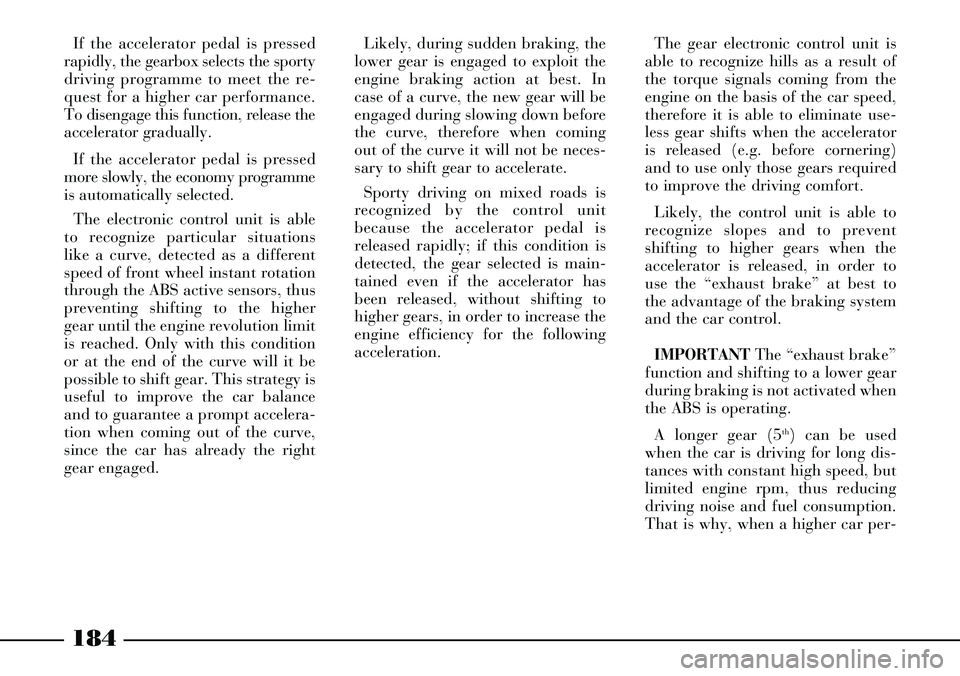
184
If the accelerator pedal is pressed
rapidly, the gearbox selects the sporty
driving programme to meet the re-
quest for a higher car performance.
To disengage this function, release the
accelerator gradually.
If the accelerator pedal is pressed
more slowly, the economy programme
is automatically selected.
The electronic control unit is able
to recognize particular situations
like a curve, detected as a different
speed of front wheel instant rotation
through the ABS active sensors, thus
preventing shifting to the higher
gear until the engine revolution limit
is reached. Only with this condition
or at the end of the curve will it be
possible to shift gear. This strategy is
useful to improve the car balance
and to guarantee a prompt accelera-
tion when coming out of the curve,
since the car has already the right
gear engaged.Likely, during sudden braking, the
lower gear is engaged to exploit the
engine braking action at best. In
case of a curve, the new gear will be
engaged during slowing down before
the curve, therefore when coming
out of the curve it will not be neces-
sary to shift gear to accelerate.
Sporty driving on mixed roads is
recognized by the control unit
because the accelerator pedal is
released rapidly; if this condition is
detected, the gear selected is main-
tained even if the accelerator has
been released, without shifting to
higher gears, in order to increase the
engine efficiency for the following
acceleration. The gear electronic control unit is
able to recognize hills as a result of
the torque signals coming from the
engine on the basis of the car speed,
therefore it is able to eliminate use-
less gear shifts when the accelerator
is released (e.g. before cornering)
and to use only those gears required
to improve the driving comfort.
Likely, the control unit is able to
recognize slopes and to prevent
shifting to higher gears when the
accelerator is released, in order to
use the “exhaust brake” at best to
the advantage of the braking system
and the car control.
IMPORTANTThe “exhaust brake”
function and shifting to a lower gear
during braking is not activated when
the ABS is operating.
A longer gear (5
th) can be used
when the car is driving for long dis-
tances with constant high speed, but
limited engine rpm, thus reducing
driving noise and fuel consumption.
That is why, when a higher car per-
Page 189 of 386

188
If the failure is signalled when the
engine is started, it means that the
electronic control unit had stored it
previously, before stopping the
engine. Even in this case, go to a
Lancia Dealershipto have the
automatic gearbox checked.
When driving with auto-
matic gearbox faulty,
drive carefully consider-
ing the limited car efficiency in
terms of acceleration and speed.
In addition, when driving with
automatic gearbox faulty, the
reverse block might not be oper-
ating: for this reason it is
absolutely necessary to move the
lever to position R while the car
is moving.SOUND SIGNAL
A buzzer will sound in the follow-
ing conditions:
– for about 15 seconds when the
driver’s door is opened while the
engine is running or not and the gear
lever has a position different from P
– for about 15 seconds when the
engine is turned off and the gear
lever has a position different from P
– for about 4 seconds when the
gear lever is shifted to R(reverse)
– with the manual sequential oper-
ation on, when the selected gear is
not accepted by the electronic con-
trol unit (e.g. since it might generate
a runaway speed rate). BUMP STARTING
Never bump starting the engine (by
pushing, towing, etc.). In an emer-
gency, when the battery is flat, start
the engine with the appropriate
emergency battery according to the
instructions contained in chapter “In
an emergency”.
Page 192 of 386

191
To make ESP, ASR and
ABS systems work prop-
erly, the tyres must
absolutely be of the same brand
and type on all wheels, in perfect
conditions and, above all, of type,
brand and size specified. stantly changed and controlled in
the attempt to keep the driver’s
direction.
The ESP system considerably
increases the car safety in several
critical conditions and it is particu-
larly useful during overtaking, when
the grip conditions on the road bed
change.ASR FUNCTION (ANTISLIP
REGULATION)
General
The ASR function is part of the
ESP system and it checks the car
drive, taking action every time one
or both driving wheels slip, thus pre-
venting car instability and tyre wear.
On the basis of slipping conditions,
two different check systems are acti-
vated:
– if slipping affects both driving
wheels, as a result of the excessive
force transmitted, the ASR function
reduces the power supplied by the
engine;
– if slipping affects only one of the
driving wheels, the ASR function
automatically brakes the slipping
wheel, with an effect similar to the
self-locking differential.The action of the ASR function is
particularly useful in the following
conditions:
– internal wheel slipping when cor-
nering due to load dynamic varia-
tions and excessive acceleration;
– excessive power supplied to
wheels according to the road bed;
– acceleration on slippery ground,
covered with snow or ice;
– in case of grip loss on wet ground
(aquaplaning).
ASR function activation
The ASR function is activated
automatically whenever the engine
is started.
During driving it is possible to dis-
engage and engage this function by
pressing button A(fig. 142) on the
central console.
When the ASR function is on, sym-
bol Vis lighted on the multifunc-
tion display together with the mes-
sage “ASR ON”.